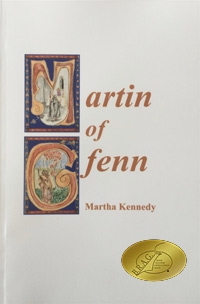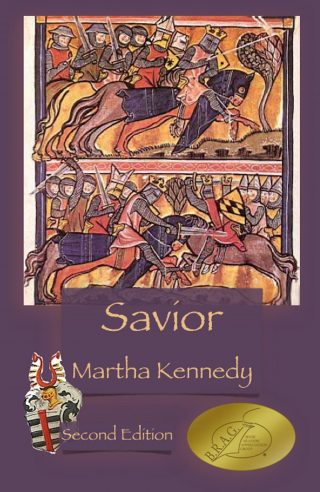Martha Kennedy
Award winning Author of BragMedallion Honorees, Martin of Gfenn and Savior
As a writer, I’ve learned a few pretty obvious lessons, but, as I have the learning style of a crash test dummy, I had to discover them for myself. It comes down to three axioms.
Axiom 1 — Give your ardor time to cool before submitting your work. While it’s cooling…
Axiom 2 — Get help with proofreading, solicit comments and help from friends, then hire a professional editor.
Axiom 3 — Stay true to your work.
**********
Axiom 1 — Submit in haste, repent at leisure.
 OR…Don’t do anything with your manuscript while you’re in love with it. Love is blind.
OR…Don’t do anything with your manuscript while you’re in love with it. Love is blind.
In 2005, when I finished (and proofread [see Axiom 2]) the initial, complete 500 manuscript pages of Martin of Gfenn, I was so INFATUATED with it that I couldn’t see that it was an overwritten, error-riddled, repetitive nightmare. Four years later, looking at it with clearer eyes, I saw the full horror of my prose.
Unfortunately, I’d already queried every possible agent. I decided (as the revised book was exponentially better than the unrevised book) to query them again. Yes, this is the biggest “NO! NO!” An absolute TABOO. I did it anyway!
You might be wondering, “How did that work out for you?”
Martin of Gfenn has since won two awards — an indieBRAG Medallion and an Editor’s Choice from the Historical Novel Society Indie Review. I am thrilled with both of them.
Axiom 2 — The more eyes that look at your manuscript the better.
I struggle with lixedysa. An “E” can become a “3,” “p” can become “q, “5 “can become “S,” and so on. Add to that the difficulty of finding editing mix-ups, typos, or homonyms that spellcheck won’t find, and clearly, well, proofreading is difficult.
I developed a method to help me with this. I “publish,” in book form, what I think might be a 90% finished novel. I make it available only to me, and I buy a few. Then, I solicit volunteers among my friends. I send each volunteer a book and ask them to write comments and corrections right on the pages. When I get the books back, it’s easy for me to find edits, corrections and comments because everyone is, uh, on the same page.
When I’ve considered everything my friends have suggested and made revisions once more, I hire a professional editor. We work together until the manuscript is polished.
To show my appreciation, I mention everyone in the acknowledgements and send them each a copy with an inscription thanking them. It’s not much, but it’s what I have.
Axiom 3 — Sometimes people just don’t like your book.
 For a short time while I was writing my third novel and sequel to Savior, The Brothers Path, I participated in an online writer’s workshop. I joined enthusiastically. I introduced myself to the other members of the workshop explaining that, 1) I wanted to be sure the story had an engaging opening, and, 2) I was looking for feedback on style. When I posted my 1000-word excerpt — the opening few paragraphs along with an explanation of the project as a whole — I did not get what I asked for; I got something more valuable to me as a writer — and as a person.
For a short time while I was writing my third novel and sequel to Savior, The Brothers Path, I participated in an online writer’s workshop. I joined enthusiastically. I introduced myself to the other members of the workshop explaining that, 1) I wanted to be sure the story had an engaging opening, and, 2) I was looking for feedback on style. When I posted my 1000-word excerpt — the opening few paragraphs along with an explanation of the project as a whole — I did not get what I asked for; I got something more valuable to me as a writer — and as a person.
The Brothers Path is the story of six brothers living in Switzerland during the Protestant Reformation. The story comprises only seven years, focusing it in time and place. It is also constrained by historical events. I knew (because of the historical record) what happened to two of the brothers, making the plot line obvious. I knew that writing about the experiences of six protagonists would require a very clear and direct story structure to maintain a unified tale. I drew a chart on 24 x 36-inch newsprint to help me keep track of history’s intersections with each brother’s life AND the intersections the brothers’ lives with each other. I had a strategy for titling the chapters that would keep things clear for my readers. None of these things were a problem for me.
Some of my classmates thought I was writing The Brothers Karamazov because my story was about brothers. Some complained that they couldn’t follow the Swiss names. Some of them insisted I back off from writing about six brothers and focus on one. Some of them said I shouldn’t write about a “heavy” topic like the Protestant Reformation, insisting, “Write what you know.” Some said, “Too ambitious.”
I began to doubt myself. I wondered if they were right. Maybe the story was too complicated, too ambitious. I considered Anglicizing the names. I nearly gave up. Then it dawned on me.
They were not READING what I was writing. They were critiquing their ideas of what I was writing. It was not my problem, or my book’s problem, that the people in my workshop wanted to read a different book. I did not have to explain, defend or justify anything. I simply had to write the book I wanted to write. I sifted through the comments, took what I could use, and shrugged off the rest.
Ultimately, The Brothers Path was accepted by two small publishers, but that’s another story and another lesson…and probably a fourth axiom.
Other posts by Martha Kennedy:
Non-Fiction and The Brothers Path
Inspiration’s Mysterious Power
Homonyms. The things your fingers type while your brain is thinking something else. Write? Right!
Rite!